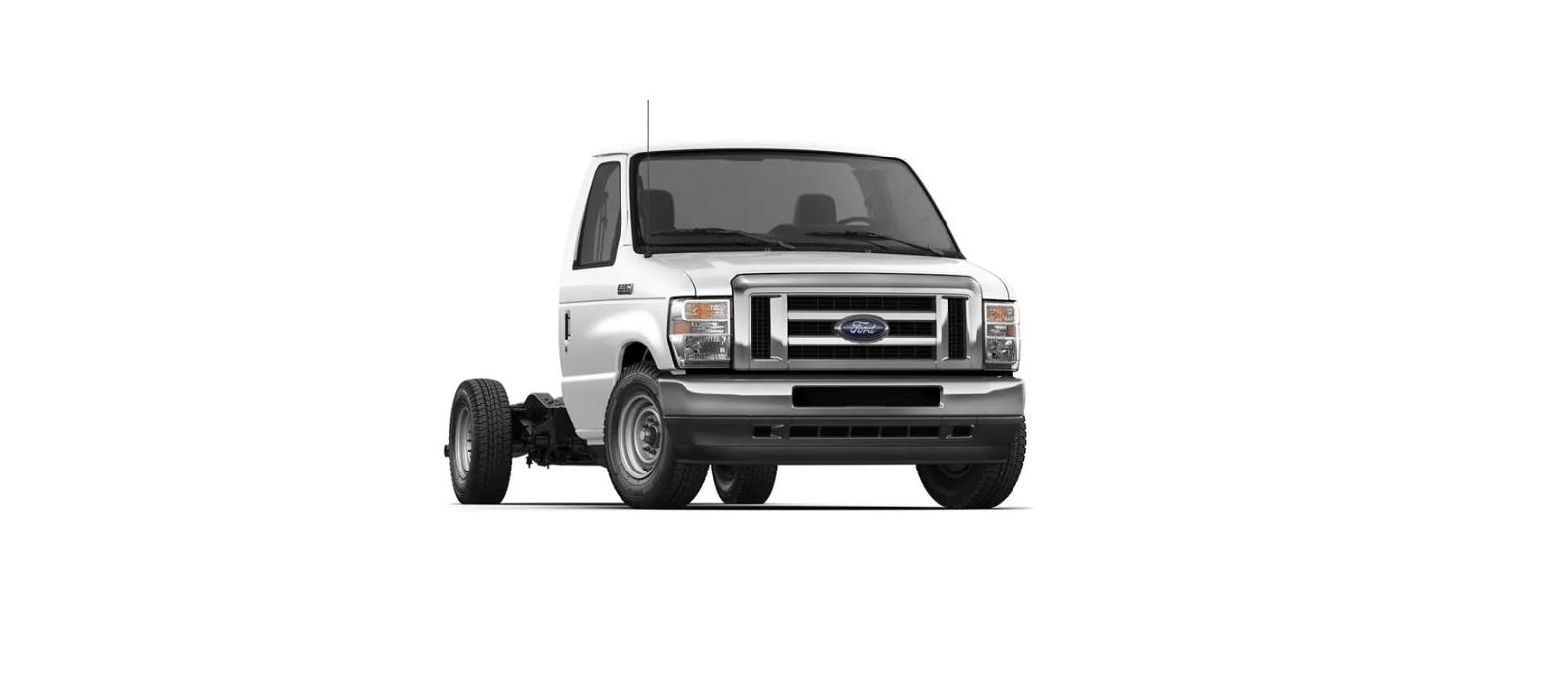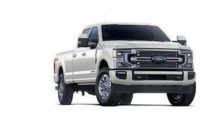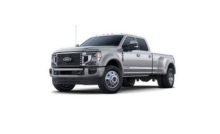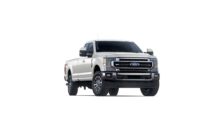2023 Ford E-350 Changing a Road Wheel




2023 Ford E-350 Changing a Road Wheel


Changing a Road Wheel
WARNING: To determine the required pressure(s) for your vehicle, see the Safety Compliance Certification Label (on the door hinge pillar, door-latch post or the door edge that meets the door-latch post, next to the driver seat) or the Tire Label on the B-Pillar or the edge of the driver door.
Note: You should only use tire sealants in roadside emergencies as they may cause damage to the tire pressure monitoring system sensor.
Note: The tire pressure monitoring system indicator light illuminates when the spare tire is in use. To restore the full function of the monitoring system, all road wheels equipped with tire pressure monitoring sensors must be mounted on the vehicle.
Note: Do not use wheels or lug nuts different than the original equipment, as this may damage the wheel or mounting system.
If you get a flat tire when driving, do not apply the brake heavily. Instead, gradually decrease your speed. Hold the steering wheel firmly and slowly move to a safe place on the side of the road. Have a flat serviced by an authorized dealer to prevent damage to the tire pressure monitoring system sensors See Tire Pressure Monitoring System (page 209). Replace the spare tire with a road tire as soon as possible. During repairing or replacing of the flat tire, have the authorized dealer inspect the tire pressure monitoring system sensor for damage.
Dissimilar Spare Wheel and Tire Assembly Information
WARNING: Failure to follow these guidelines could result in an increased risk of loss of vehicle control, injury or death.
If you have a dissimilar spare wheel and tire, then it is intended for temporary use only. This means that if you need to use it, you should replace it as soon as possible with a road wheel and tire assembly that is the same size and type as the road tires and wheels that were originally provided by Ford. If the dissimilar spare tire or wheel is damaged, it should be replaced rather than repaired.
A dissimilar spare wheel and tire assembly is defined as a spare wheel and tire assembly that is different in brand, size or appearance from the road tires and wheels and can be one of three types:
- 1. T-type mini-spare: This spare tire begins with the letter T for tire size and may have Temporary Use Only molded in the sidewall.
- Full-size dissimilar spare with label on wheel: This spare tire has a label on the wheel that states: THIS WHEEL AND TIRE ASSEMBLY FOR TEMPORARY USE ONLY.
When driving with one of the dissimilar spare tires listed above:- Do not exceed 50 mph (80 km/h).
- Do not load the vehicle beyond maximum vehicle load rating listed on the Safety Compliance Label.
- Do not tow a trailer.
- Do not use snow chains on the end of the vehicle with the dissimilar spare tire.
- Do not use more than one dissimilar spare tire at a time.
- Do not use commercial car washing equipment.
- Do not try to repair the dissimilar spare tire.
Using a dissimilar spare wheel and tire assembly can compromise the effectiveness of the following: - Handling, stability and braking performance.
- Comfort and noise.
- Ground clearance and parking at curbs.
- Winter weather driving capability.
- Wet weather driving capability.
- All-wheel driving capability.
- Full-size dissimilar spare without label on wheel
When driving with the full-size dissimilar spare wheel and tire assembly:- Do not exceed 70 mph (113 km/h).
- Do not use more than one dissimilar spare wheel and tire assembly at a time.
- Do not use commercial car washing equipment.
- Do not use snow chains on the end of the vehicle with the dissimilar spare wheel and tire assembly. Using a dissimilar spare wheel and tire assembly can compromise the effectiveness of the following :
- Handling, stability and braking performance.
- Comfort and noise.
- Ground clearance and parking at curbs.
- Winter weather driving capability.
- Wet weather driving capability.
- All-wheel driving capability.
When driving with the full-size dissimilar spare wheel and tire assembly additional caution should be given to: - Towing a trailer.
- Driving vehicles equipped with a camper body.
- Driving vehicles with a load on the cargo rack.
Drive cautiously when using a full-size dissimilar spare wheel and tire assembly and seek service as soon as possible.
Tire Change Procedure
WARNING: The jack supplied with this vehicle is only intended for changing a flat tire in an emergency. Do not attempt to do any other work on your vehicle when it is supported by the jack, as your vehicle could slip off the jack. Failure to follow this instruction could result in personal injury or death.
WARNING: To help prevent your vehicle from moving when changing a wheel, shift the transmission into park (P), set the parking brake and use an appropriate block or wheel chock to secure the wheel diagonally opposite to the wheel being changed. For example, when changing the front left wheel, place an appropriate block or wheel chock on the right rear wheel.
WARNING: Do not attempt to change a tire on the side of the vehicle close to moving traffic. Pull far enough off the road to not obstruct the flow of traffic and avoid the danger of being hit when operating the jack or changing the wheel.
WARNING: Only use the jack provided as original equipment with your vehicle.
WARNING: The jack supplied with this vehicle is only intended for changing a flat tire in an emergency.
Do not attempt to do any other work on your vehicle when it is supported by the jack, as your vehicle could slip off the jack. Failure to follow this instruction could result in personal injury or death.
WARNING: Only use the jack provided as original equipment with your vehicle.
WARNING: Never place anything between the vehicle jack and your vehicle.
WARNING: Never place anything between the vehicle jack and the ground.
WARNING: Only use the specified jacking points. If you use any other locations you could damage vehicle components, such as brake lines.
WARNING: Failure to follow these guidelines could result in an increased risk of loss of vehicle control, injury or death.
WARNING: Switch off the running boards before jacking or placing any object under your vehicle. Never place your hand between the extended running board and your vehicle. A moving running board may cause injury.
WARNING: Only use the spare wheel carrier to stow wheels provided with your vehicle.
Note: Passengers should not remain in your vehicle when the vehicle is being jacked.
Note: Do not use impact tools or power tools operating at over 200 RPM on the spare wheel carrier winch, which may cause it to malfunction and prevent a secure fit.
Override the winch at least three times (there is an audible click each time) to make sure the wheel and tire fit securely
Note: No maintenance or additional lubrication of your jack is required over the service life of your vehicle.
- Park the vehicle on a level firm ground and activate the hazard flashers.
- Apply the parking brake, place the transmission in park (P), turn the engine off.
- Block the wheel diagonally opposite the flat tire. For example, if the left front tire is flat, block the right rear wheel.
Removing the Jack and Tools
The jack and tools are located in the rear right-hand side of the cargo area. Remove the jack and tools from the storage location.
Jack and Tool Stowage Regular Van/Wagon:
Jack and Tool Stowage Extended Van/Wagon:
Hydraulic Jack:
Removing the Spare Tire
- To remove the spare tire, remove the jack handle from the right side compartment, open the rear doors and remove the thumbscrew and anti-theft bracket. If finger pressure will not remove the thumbscrew, use the lug nut wrench tip to loosen it.
- Remove the access cover from the rubber strip. Guide the lug wrench or jack handle through the hole and into the tube.
- Turn the wrench or handle counterclockwise until the cable has slack and the tire can be slid rearward.
- Remove the retainer from the spare tire and remove the spare tire.
- Use the lug nut wrench to remove the wheel trim, if equipped.
- Loosen each wheel lug nut one-half turn counterclockwise. Do not remove them until the wheel is raised off the ground.
- For E-350 dual wheel and E-450 equipped with hydraulic jacks, two handle extensions are used to operate the jack. To assemble, align the button with the hole and slide the parts together. To disconnect, press the button and pull apart.
Jacking the Vehicle
Position the jack under the correct jacking points according to following pictures.
Front axle jacking point: Place the jack under the pin on the front surface of the front axle.
Note: Do not place the jack under or on the steering linkage.
Rear axle jacking points: All models except E-350 and E-450 dual rear wheel.
Rear axle jacking points: E-350 and E-450 dual rear wheel.
Turn the jack handle clockwise. For hydraulic jacks, operate the handle up and down until the wheel is completely off the ground and high enough to install the spare tire.
Installing the spare wheel and tire
- Remove the lug nuts with the lug wrench, replace the flat tire with the spare, making sure the valve stem of the spare is facing outward when replacing a front wheel. For the rear wheel position on vehicles with single rear wheel fitments, install the spare with the valve stem facing outward.
For vehicles with dual rear wheels, the valve stem of the spare must face outward when replacing an inner wheel, but must face inward when replacing an outboard wheel. - Install the lug nuts and finger tighten.
Do not fully tighten the lug nuts until the wheel has been lowered. - Lower the vehicle completely by turning the jack handle counterclockwise.
Note: For hydraulic jacks, insert the release valve, open the release valve slightly by turning the handle counterclockwise. Stop turning the release valve when vehicle start to lower. Close the valve when the vehicle is completely lowered. - Install the lug nuts in the sequence shown.
- Remove the jack and fully tighten the lug nuts in the sequence shown. See Technical Specifications (page 222).
6. Install any wheel covers or hubcaps. Make sure they snap into place.
Note: When installing the wheel center ornaments, make sure that the ornament retention towers on the backside of the ornament are aligned with the studs and wheel nuts and retain to the flange on the wheel nuts.
Stowing the Flat tire or Spare tire
- Place the tire on end with the valve stem facing toward the front of the vehicle. Lay the tire on the ground, near the rear of the vehicle, with the valve stem side facing up.
- Slide the wheel partially under the vehicle and install the retainer through the wheel center. If equipped, you may have to remove the wheel center cap prior to pushing the retainer through the center of the wheel. To remove the center cap, press it off with the lug wrench tip from the inner side of the wheel. Pull on the cable to align the components at the end of the cable.
- Turn the lug wrench clockwise until the tire is raised to its stowed position underneath the vehicle. The wrench becomes harder to turn and the spare tire winch ratchets or slips when the tire is raised to its maximum tightness.
A clicking sound is heard from the winch indicating that the tire is properly stowed. Check that the tire lies flat against the frame and is properly tightened. - Reinstall the tools and tighten the wing nut.
- Reinstall the jack properly into the bracket and tighten the wing nut.
- Unblock the wheel.
Recent Posts
VW Jetta Engine Fuse Box Diagram
Access the comprehensive 2010-2018 VW Jetta Passenger Fuse Box Diagram to troubleshoot electrical issues effectively.…
VW Jetta Passenger Fuse Box Diagram
Explore the comprehensive VW Jetta Passenger Fuse Box Diagram to troubleshoot electrical issues effectively. Understand…
2023 Ford F-150 Lightning Fuse Box Diagram
Under Hood Fuse Box Location Remove the front luggage compartment cover. Under Hood Fuse Box…
2022 Kawasaki NINJA H2 SX SE Brake Lever Adjuster Owner’s Manual
2022 Kawasaki NINJA H2 SX SE Brake Lever Adjuster Owner's Manual NOTICE Only adjust the front…
2023 Land Rover Range Rover Evoque Exiting The Vehicle Owners Manual
2023 Land Rover Range Rover Evoque Exiting The Vehicle SINGLE LOCKING WARNING Before exiting the…
2023 Land Rover Range Rover Evoque Front Seats Owners Manual
2023 Land Rover Range Rover Evoque Front Seats FRONT SEAT SAFETY Make sure to read…


